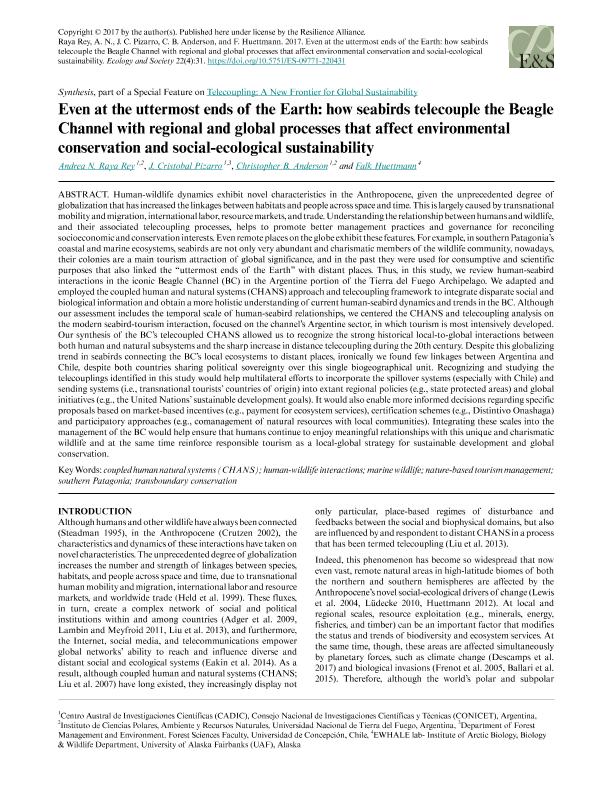Artículo
Even at the uttermost ends of the Earth: how seabirds telecouple the Beagle Channel with regional and global processes that affect environmental conservation and socio-ecological sustainability
Raya Rey, Andrea Nélida ; Pizarro Pinochet, Jose Cristobal
; Pizarro Pinochet, Jose Cristobal ; Anderson, Christopher Brian
; Anderson, Christopher Brian ; Huettmann, Falk
; Huettmann, Falk
 ; Pizarro Pinochet, Jose Cristobal
; Pizarro Pinochet, Jose Cristobal ; Anderson, Christopher Brian
; Anderson, Christopher Brian ; Huettmann, Falk
; Huettmann, Falk
Fecha de publicación:
12/2017
Editorial:
Resilience Alliance
Revista:
Ecology and Society
ISSN:
1708-3087
Idioma:
Inglés
Tipo de recurso:
Artículo publicado
Clasificación temática:
Resumen
Human-wildlife dynamics exhibit novel characteristics in the Anthropocene, given the unprecedented degree of globalization that has increased the linkages between habitats and people across space and time. This is largely caused by transnational mobility and migration, international labor, resource markets, and trade. Understanding the relationship between humans and wildlife, and their associated telecoupling processes, helps to promote better management practices and governance for reconciling socioeconomic and conservation interests. Even remote places on the globe exhibit these features. For example, in southern Patagonia’s coastal and marine ecosystems, seabirds are not only very abundant and charismatic members of the wildlife community, nowadays, their colonies are a main tourism attraction of global significance, and in the past they were used for consumptive and scientific purposes that also linked the “uttermost ends of the Earth” with distant places. Thus, in this study, we review human-seabird interactions in the iconic Beagle Channel (BC) in the Argentine portion of the Tierra del Fuego Archipelago. We adapted and employed the coupled human and natural systems (CHANS) approach and telecoupling framework to integrate disparate social and biological information and obtain a more holistic understanding of current human-seabird dynamics and trends in the BC. Although our assessment includes the temporal scale of human-seabird relationships, we centered the CHANS and telecoupling analysis on the modern seabird-tourism interaction, focused on the channel’s Argentine sector, in which tourism is most intensively developed. Our synthesis of the BC’s telecoupled CHANS allowed us to recognize the strong historical local-to-global interactions between both human and natural subsystems and the sharp increase in distance telecoupling during the 20th century. Despite this globalizing trend in seabirds connecting the BC’s local ecosystems to distant places, ironically we found few linkages between Argentina and Chile, despite both countries sharing political sovereignty over this single biogeographical unit. Recognizing and studying the telecouplings identified in this study would help multilateral efforts to incorporate the spillover systems (especially with Chile) and sending systems (i.e., transnational tourists’ countries of origin) into extant regional policies (e.g., state protected areas) and global initiatives (e.g., the United Nations’ sustainable development goals). It would also enable more informed decisions regarding specific proposals based on market-based incentives (e.g., payment for ecosystem services), certification schemes (e.g., Distintivo Onashaga) and participatory approaches (e.g., comanagement of natural resources with local communities). Integrating these scales into the management of the BC would help ensure that humans continue to enjoy meaningful relationships with this unique and charismatic wildlife and at the same time reinforce responsible tourism as a local-global strategy for sustainable development and global conservation.
Archivos asociados
Licencia
Identificadores
Colecciones
Articulos(CADIC)
Articulos de CENTRO AUSTRAL DE INVESTIGACIONES CIENTIFICAS
Articulos de CENTRO AUSTRAL DE INVESTIGACIONES CIENTIFICAS
Citación
Raya Rey, Andrea Nélida; Pizarro Pinochet, Jose Cristobal; Anderson, Christopher Brian; Huettmann, Falk; Even at the uttermost ends of the Earth: how seabirds telecouple the Beagle Channel with regional and global processes that affect environmental conservation and socio-ecological sustainability; Resilience Alliance; Ecology and Society; 22; 4; 12-2017; 31-31
Compartir



